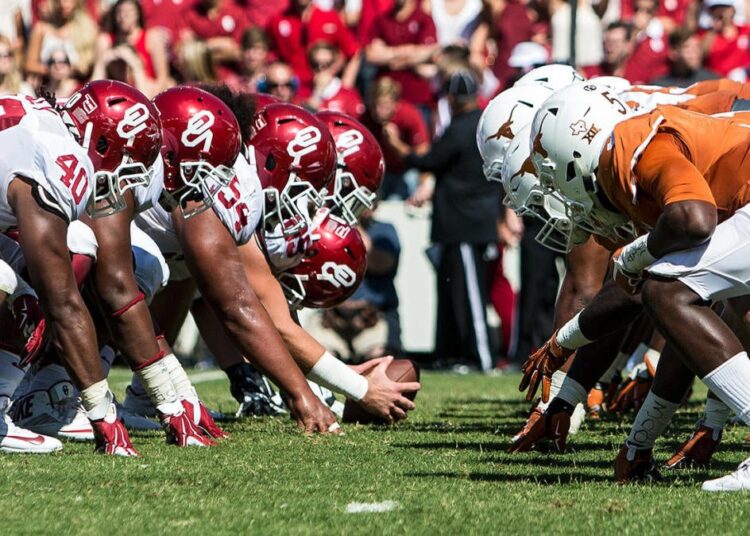Texas and Oklahoma have reached an early exit agreement with the Big 12 that will see the powers depart for the SEC following the 2023-24 athletic season. The Big 12 and both programs announced Thursday night that the Longhorns and Sooners will pay early withdrawal fees of a combined $100 million to join the SEC in 2024, a full season earlier than originally planned.
The Big 12’s two most prominent programs made waves in July 2021 when they accepted invitations to join the SEC, setting off the latest round of conference realignment. At the time, Texas and Oklahoma planned to move to the SEC beginning July 1, 2025, once the Big 12’s active grant of rights agreement expired, opening the door for UT and OU to depart the conference free and clear.
However, once the Big 12 backfilled its membership by adding BYU, Cincinnati, Houston and UCF — all joining the league for the 2023 season — momentum began to shift toward the Longhorns and Sooners leaving for the SEC earlier than scheduled. Texas and Oklahoma not only preferred to avoid playing the new Big 12 members, they wanted to join the SEC for Year 1 of its new TV deal with ESPN. The Big 12 eyed the substantial exit fee to supplement the new six-year media rights deal it negotiated with Fox and ESPN in October 2022.
The eight legacy Big 12 teams agreed to share a portion of their media rights distributions from the Big 12’s existing deals with Fox and ESPN to make possible the four-team expansion. Each program decided to forgo $16 million total ($8 million annually in 2023-24 and 2024-25) in future monies, sources previously told CBS Sports’ Dennis Dodd.
The negotiated $100 million early exit fee the Big 12 will receive from Texas and Oklahoma for not being part of the league’s media package in 2025 — down from a sum that could have totaled as much as $168 million — will likely be used to make whole those eight legacy programs.
In a separate deal, Texas and Oklahoma agreed to pay cash to Fox in exchange for their games leaving the network a year early, sources told Dodd.
Furthermore, a scheduled two-game series between Texas and Michigan has seen a location swap, according to multiple reports. The Wolverines will now host the Longhorns in 2024, allowing the game to air on Fox, with UT hosting UM in 2027 on ESPN.
Texas and Oklahoma — alone or together — are two of the most valuable TV properties in the sport. Last season, either or both played in a top five-rated game in six of the 13 regular-season weeks.
“As I have consistently stated, the conference would only agree to an early withdrawal if it was in our best interest for Oklahoma and Texas to depart prior to June 30, 2025,” Big 12 commissioner Brett Yormark said in a statement announcing the deal. “By reaching this agreement, we are now able to accelerate our new beginning as a 12-team league and move forward in earnest with our initiatives and future planning.”
SEC commissioner Greg Sankey subsequently announced that his league’s office will “proceed with facilitating the transition” of Texas and Oklahoma to the SEC beginning July 1, 2024, one year earlier than originally approved.
Not only will the Longhorns and Sooners now join the SEC as it begins its new media rights deal with ESPN in 2024, that season also marks the first year of the expanded 12-team College Football Playoff and the transition of USC and UCLA from the Pac-12 to the Big Ten.
The SEC and Big Ten will both become 16-team conferences starting in 2024. The Big 12 will play with 14 members in 2023 before moving back to 12 teams in 2024 unless it expands further, which is believed to be on Yormark’s radar.
What will SEC schedules look like?
The expedited additions of Texas and Oklahoma puts an onus on the SEC to finalize a new scheduling format soon. Two formats remain in play for the soon-to-be 16-team league. One is an eight-game league schedule with one permanent opponent for each team. The other is a nine-game schedule in which each team would play three permanent opponents.
Conference administrators are expected to discuss the matter at the annual spring meetings in March. While the SEC appears to be leaning toward a nine-game conference schedule without divisions, it is seeking additional funds from ESPN — its exclusive media rights partner starting in 2024 — for the additional league games.
With each program playing three permanent opponents and six rotating opponents as part of a nine-game SEC slate, teams to play every conference opponent at least twice every four years (home and away).
The SEC released its 2023 football schedule in September 2022. If the league wants to release its 2024 schedule on a similar timeline, the conference only has a matter of months to hammer out a new format and produce a schedule that that involves the Longhorns and Sooners.
Pressure ratchets up for coaches
From an on-field perspective, moving to the SEC in 2024 will only increase pressure on two coaches still trying to find their way. Brent Venables is coming off a 6-7 debut campaign at Oklahoma after a decade on staff at Clemson. Texas coach Steve Sarkisian is just 13-12 in two seasons with the ‘Horns but has recent experience in the SEC serving as Alabama’s offensive coordinator in 2019-20.
While playing in the Big 12 is no pushover, moving to the SEC a year ahead of schedule only increases the degree of difficulty for Venables and Sarkisian, particularly if the league moves to a nine-game schedule. Though both programs have the facilities, internal resources and external booster backing to field competitive SEC teams, they will no longer hold distinct advantages on their league peers in those facets (as they have for much of their time in the Big 12).
One potential saving grace for the programs amid their transition to the SEC will be the expansion of CFP from four to 12 teams beginning with the 2024 season. If Texas and Oklahoma are unable to immediately topple established SEC programs in the league title hunt, the expanded playoff field will provide an attainable but still meaningful goal for both programs.
Big 12’s response
The Big 12 has further expansion plans, which were in place prior to the early exits of UT and OU but will now ramp up even further, sources tell Dodd.
Though the departures are a hit to the league’s brand, losing them early is not entirely devastating as the Big 12 has already agreed to terms on $2.3 billion extension of its media rights deal, and legacy members should see much of the revenue they agreed to disperse to new programs recouped.
With the Pac-12 eyeing San Diego State from the Mountain West and SMU from the AAC as potential new members, plenty of appealing expansion options remain on the table for the Big 12. Yormark has been on the job less than a year yet proven to be an aggressive leader with an outside perspective on the collegiate sports landscape following a career in the entertainment industry.
Though football drives revenue in college sports, the new-look Big 12 is also positioned to remain among the best, if not the best, conference on the court in men’s basketball. A pursuit of Gonzaga as a basketball-only member may further that notion.
Read the full article here


























